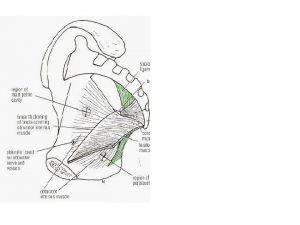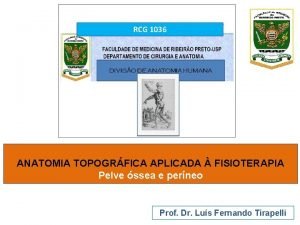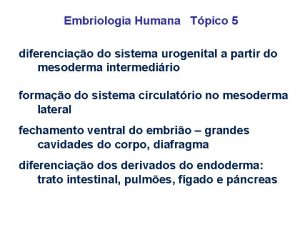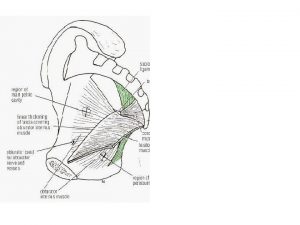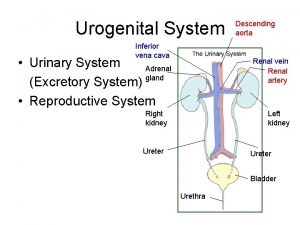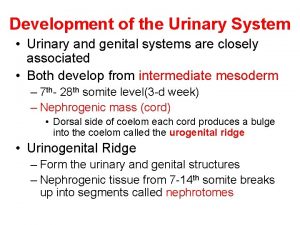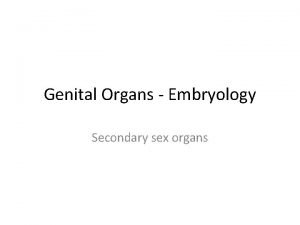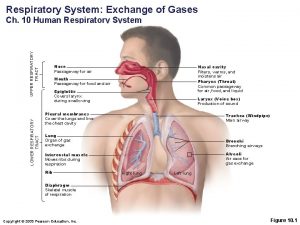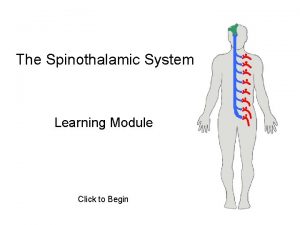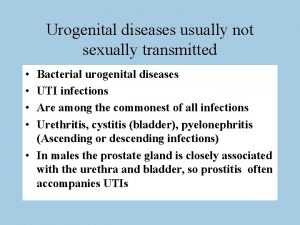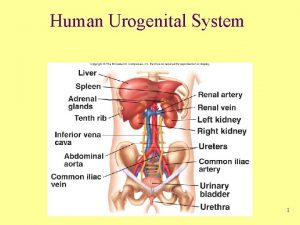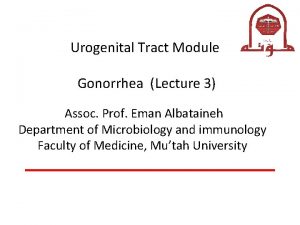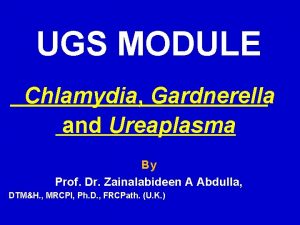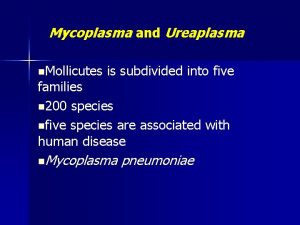Urogenital Tract Module Gardenella and ureaplasma Dr Eman









































- Slides: 41

Urogenital Tract Module Gardenella and ureaplasma Dr. Eman Albataineh Associate Prof. Immunology Department of Microbiology Mutah University 1

What is Bacterial vaginosis • Bacterial vaginosis is the most common cause of abnormal vaginal odour and discharge. It is caused by a change in the type of bacteria found in the vagina. Normally, bacteria belonging mostly to the Lactobacillus family live harmlessly in the vagina and produce chemicals that keep the vagina mildly acidic. In bacterial vaginosis, Lactobacillus bacteria are replaced by other types of bacteria that normally are present in smaller concentrations in the vagina. 2

Risk factors • Risk factors that seem to increase the likelihood of bacterial vaginosis include a history of multiple sex partners, a sexual relationship with a new partner, cigarette smoking, vaginal douching and the use of intrauterine contraceptive device (IUD). Although most of these risk factors are related to sexual activity, women who have never had vaginal intercourse can also develop bacterial vaginosis. 3

Bacterial vaginosis and pregnancy • Bacterial vaginosis often occurs during pregnancy. It may cause premature labor and delivery, premature rupture of membranes, and postpartum uterine infections. This is why pregnant women with a history of premature labor or other complications may be checked for bacterial vaginosis even when they don’t have any symptoms. 4

Gardnerella Vaginitis • Gram-variable-staining rod, facultative anaerobic bacteria (actually has a Gram-positive cell wall, but because the cell wall is so thin it can appear either Gram-positive or Gram-negative under the microscope). • Small (1 -1. 5 µm diameter) non-spore forming, non-motile coccobacilli. • Previously classified as Haemophilus vaginalis and afterwards as Corynebacterium vaginalis. 5

Gardnerella Vaginitis • Growth: grows as small, circular, convex, gray colonies on chocolate agar; it also grows on HBT agar. • Can cause bacterial vaginosis in some women as a result of a disruption in the normal vaginal micro flora. 6

Can be isolated from other Areas • Typically isolated in genital cultures. May also be detected in other samples from blood, urine, and pharynx 7

Morphology • Small, Gram negative, on motile • Pleomorphic rod which shows metachromatic granules • Presence of Clue cells 8

Gram Stain still the simple in diagnosis of Bacterial Vaginosis • The Centers for Disease Control and Prevention (2010) also recommend the gram stain as the gold standard for diagnosis of bacterial vaginosis 9

Culturing • Grows on Blood and Chocolate Agar • Hemolytic colonies on Human and Rabbit blood agar, • Catalase – • Oxidase – 10

Symptoms • Up to 50% of women diagnosed with bacterial vaginosis do not have symptoms. In others, it causes an unpleasant “fishy” vaginal odor and a yellow or white vaginal discharge. For some women, these symptoms are especially bothersome during or after intercourse. 11

Observation of Vaginal Discharge • The discharge seen in bacterial vaginosis tends to be thinner than “cheesy”, thick discharge seen in vaginal yeast (Candida) infections. Bacterial vaginosis usually does not cause significant irritation of the vulva or pain during intercourse. If you have these symptoms, your doctor will check for other possible causes. 12

No perfect test • There is no perfect test, but if you have three of the following four criteria, it is highly likely that you have bacterial vaginosis: • 1 White, thin, coating on your vaginal walls during the pelvic exam 13

Diagnosis • 2 p. H test of vaginal discharge that shows low acidity (p. H greater than 4. 5) • 3 Fishy odor when a sample of vaginal discharge is combined with a drop of potassium hydroxide on a glass slide (the “whiff test”) 14

Clue cells • 4 Clue cells (vaginal skin cells that are coated with bacteria) visible on microscopic exam of vaginal fluid 15

Newer methods in diagnosis of Genital Infections • DNA probes have been developed to directly detect the presence of candida, trichomonas and Gardnerella, thus providing a more objective diagnosis. Since Gardnerella is a normal part of the vaginal flora, the DNA probe test is designed to be relatively insensitive, detecting only pathogenic levels of Gardnerella. The Affirm VP III Microbial Identification System (Becton Dickinson) is a commercially available DNA probe office-based test kit that simultaneously detects the presence of Gardnerella, trichomonas and candida. 16

Treatment • Commonly treat bacterial vaginosis with metronidazole (Flagyl or Metro. Gel-Vaginal) or clindamycin (Cleocin). Either can be taken by mouth or applied as a vaginal cream or gel. However, the U. S. Centers for Disease Control and Prevention (CDC) recommends that all pregnant women with symptoms be treated with oral medications because the medications are safe and work better than vaginal creams or gels. 17

GENITAL MYCOPLASMAS • Three Mycoplasma species, • Mycoplasma hominis, • Mycoplasma genitalium, • Ureaplasma urealyticum. • are human urogenital pathogens. They are often associated with sexually transmitted infections, such as NGU (nongonococcal urethritis) or puerperal infections (that is, infections connected with, or occurring during childbirth or the period immediately following childbirth). 18

Ureaplasma urealyticum is part of the normal genital flora of both men and women. It stains gram negative, but that is because it lacks a cell wall. It is found in about 70% of sexually active humans. Symptoms can be "silent" or can cause noticeable symptoms such as discharge, burning, urinary frequency, urinary urgency, and pain. • Ureaplasma urealyticum is a common cause of urethritis when neither gonococcus nor chlamydia can be demonstrated, particularly in men. • In women, the organism has been isolated from the endometrium of patients with endometritis and from vaginal secretions of women who undergo premature labor or deliver low-birth-weight babies. • The infants are often colonized, and Ureaplasma urealyticum has been isolated from the infant’s lower respiratory tract and CNS both with and without evidence of inflammatory response. • • 19

Ureaplasma urealyticum • It had been associated with a number of diseases, including nonspecific urethritis (NSU), infertility, stillbirth, premature birth. • They grow more rapidly than M. pneumoniae and can be distinguished by their carbon utilization patterns: M. hominis degrades arginine, whereas U. urealyticum hydrolyses urea. • Treatment: • A tetracycline, such as doxycyline, is effective for specific treatment 20

Urogenital Tract Module Chlamydia Dr. Eman Albataineh Associate prof. in Immunology Department of Microbiology and Immunology Faculty of Medicine, Mu’tah University 21

Epidemiology Ø Is a STDs Ø In USA over 900, 000 cases are reported each year, which is three times the number for gonorrhea (2004) Ø The cases among males and females are higher than in gonorrhea Ø Prevalence in pregnant women 6% - 12% Ø Reinfection is frequent Reported Sexually Transmitted Diseases, United States, 2004 22

Chlamydia curriculum Ø Obligatory intracellular bacteria Ø Intracellular replication that results in the death of the cell Ø weakly Gram-negative bacterium. It is ovoid in shape and nonmotile Ø Three species: C. trachomatis, C. psittaci, C. pneumoniae Q: Why Chlamydia is an obligatory intracellular parasite? Ø No flavoproteins or cytochromes, therefore, lacking ATP-generating ability Ø Need to obtain ATP from the host cell. Ø Called energy parasites 23

Chlamydia curriculum Chlamydial Morphologies and life cycle Takes on two forms in its life cycle: 1 - Elementary body – about 0. 3 um in diameter – infectious nonreplicating – condensed genetic material – released from ruptured infected cells 2 - Reticulate Body – intracytoplasmic form 0. 5 - 1. 0 um – non-infectious replicating form – replication and growth in an inclusion body – diffuse genetic material Host cell RB Inclusion body 48 h post infection 24

Chlamydia curriculum Life cycle 48 -72 hr 25

Clinical syndromes Strains causing human diseases C. trachomatis strains Associated diseases Ocular strains (A, B, Ba, C) Conjunctivitis, trachoma, infant pneumonia, Genital strains (D-K) Genital strains (L 1, L 2, L 3) Nongonoccocal urithritis, Mucopurulent cervicitis, pelvic inflammatory disease (PID) Lymphogranuloma venereum (LGV) 26

Clinical syndromes caused by C. trachomatis Men Women Infants 27

Pathogenesis • Chlamydiae have a tropism for epithelial cells of the endocervix and upper genital tract of women, and the urethra, rectum and conjunctiva of both sexes. • Once infection is established, there is a release of proinflammatory cytokines by infected epithelial cells. • This results in early tissue infiltration by PMNs, later followed by lymphocytes, macrophages, plasma cells and eosinophils. • If the infection progresses further (because of lack of treatment and/or failure of immune control), aggregates of lymphocytes and macrophages (lymphoid follicles) may form in the submucosa; these can progress to necrosis, followed by fibrosis and scarring. 28

Pathogenesis Normal Infected 29

Pathogenesis How does Chlamydia affect pregnancy? • Chlamydia can cause a pregnant woman to go into labor early or deliver a low-birth weight baby. • Chlamydia can spread from mother to baby during birth. This can cause pneumonia or a serious infection in the baby’s eye that may lead to blindness. • A pregnant woman can be treated to prevent transmission to the baby. 30

Clinical syndromes Urethritis In Men Ø The most common cause of nongonococcal urethritis (NGU) in men (40 to 96 percent) Ø More common than gonococcal infection Ø Majority (>50%) are asymptomatic Ø The incubation period is variable but is typically 5 to 10 days after exposure Ø Symptoms ü mucoid or clear urethral discharge with bad smell ü dysuria Ø Sometimes the discharge is so scant (thick, white, odorless, and curd-like) like cottage cheese. This is in contrast to the more copious and purulent urethral discharge and shorter (two to seven days) incubation period for gonococcal urethritis 31

Clinical syndromes In Men Epididymitis Men with acute epididymitis typically have testicular pain and tenderness, hydrocele, and palpable swelling of the epididymis. Prostatitis Symptoms included – dysuria – urinary dysfunction – pain with ejaculation – pelvic pain 32

Clinical syndromes In woman Urethritis – Usually asymptomatic – Signs/symptoms, when present, include dysuria, frequency, pyuria Cervicitis – Majority (70%-80%) are asymptomatic – Local signs of infection, when present, include: • mucopurulent endocervical discharge • cervical edema with erythema and friability Cervicitis Normal Cervix 33

Clinical syndromes In woman Complications in Women • Pelvic Inflammatory Disease (PID) – Salpingitis – Endometritis Normal fallopian tube C. trachomatis infection (PID) Acute Salpingitis 34

Clinical syndromes Proctitis Ø Defined as inflammation of the distal rectal mucosa Ø The clinical presentation depends on the infecting chlamydial serovars – LGV serovars: anorectal pain, mucopurulent exudate, tenesmus, rectal bleeding and constipation. If left untreated, can lead to rectal fistulae and strictures – The non-LGV: the infections are usually asymptomatic Reiter’s Syndrome (reactive arthritis ) Characterized by a triad of – Arthritis – nongonococcal urethritis – conjunctivitis 35

Clinical syndromes Lymphogranuloma venereum (LGV) Ø primarily an infection of lymphatics and lymph nodes Ø It gains entrance through breaks in the skin, or it can cross the epithelial cell layer of mucous membranes. Ø The organism travels down to multiply in the lymph nodes Stages Primary stage Ø A self-limited painless genital ulcer that occurs at the contact site 3– 12 days after infection Ø Unobserved in most cases Ø Heals in a few days 36

Clinical syndromes Secondary stage • occurs 10– 30 days later, but can present up to six months. • The infection spreads to the lymph nodes through lymphatic drainage pathways. • causing tender inguinal and/or femoral Lymphadenopathy • These changes may progress to necrosis Third stage • Healing of necrosis takes place by fibrosis. • This can result in varying degrees of lymphatic obstruction and chronic edema • Causing genital elephantiasis 37

STDs comparison Syphilis Herpes genitalis § firm painless ulceration § 5– 15 mm and sharply demarcated § often, a painless nontender inguinal lymphadenopathy § group of vesicles on an erythematous base § after rupturing, they form an ulcer § heal within 1– 4 weeks H. ducruyi § soft Painful deep purulent ulcers (2– 20 mm) § painfull Lymphadenopathy. § Swollen lymph nodes can break through the skin and lead to large abscesses (collections of pus) that drain LGV • painless ulcer (2– 10 mm). • the genital ulcers heal spontaneously. • tender and painful lymphadenopathy is a typically symptom of LGV 38

diagnosis • The preferred method for chlamydia testing is the nucleic acid amplification test (NAAT) that detects the genetic material (DNA) of Chlamydia trachomatis • A urine test. A sample of your urine is analyzed in the laboratory for presence of this infection. • A swab. For women, your doctor takes a swab of the discharge from your cervix for culture or antigen testing for chlamydia. 39

diagnosis • Typical intracytoplasmic inclusions in Giemsa-stained cell scrapings from the conjunctiva. • polymerase chain reaction (PCR) in first-void urine. • Positive culture in Mc. Coy or He. La cells of body fluids or secretions. • Serology test in patients with presumed lymphogranuloma venereum. 40

Treatment • Tetracyclin • Azithromycin • Erythromycin in children 41
 Eman nayyab
Eman nayyab Eman güvenlik
Eman güvenlik Extrapyramidal tract function
Extrapyramidal tract function Olivospinal tract vs tectospinal tract
Olivospinal tract vs tectospinal tract Ureaplasma pozitiva
Ureaplasma pozitiva Ureaplasma selbstheilung
Ureaplasma selbstheilung Ureaplasma sintomas
Ureaplasma sintomas Fascia of urogenital triangle
Fascia of urogenital triangle Urogenital triangle
Urogenital triangle Urogenital groove
Urogenital groove Ilio isquio e púbis
Ilio isquio e púbis Respiratory system fetal pig
Respiratory system fetal pig Vertical
Vertical Piggender
Piggender Male fetal pig reproductive system labeled
Male fetal pig reproductive system labeled Vasos deferentes
Vasos deferentes Development of urinary bladder
Development of urinary bladder Cat dissection
Cat dissection Urogenital triangle
Urogenital triangle Vena cava excretory system
Vena cava excretory system Female sex organ
Female sex organ Urogenital ridge
Urogenital ridge Mezonefroz
Mezonefroz Urogenital ridge
Urogenital ridge Sistema urogenital animal
Sistema urogenital animal Sexo.
Sexo. Urogenital sinus derivatives
Urogenital sinus derivatives Development of urethra
Development of urethra C device module module 1
C device module module 1 Corticospinal tract
Corticospinal tract Extrapyramidal system
Extrapyramidal system Vestibulospinal tract origin
Vestibulospinal tract origin Difference between pyramidal and extrapyramidal tract
Difference between pyramidal and extrapyramidal tract Upper and lower respiratory system
Upper and lower respiratory system Alimentary tract and metabolism
Alimentary tract and metabolism Root word of tract
Root word of tract Homonynous
Homonynous Vestibulospinal tract origin
Vestibulospinal tract origin Sacule
Sacule Internal capsule tract
Internal capsule tract Walter mitty quotes
Walter mitty quotes What does the inside of a human stomach look like
What does the inside of a human stomach look like







